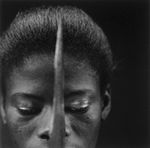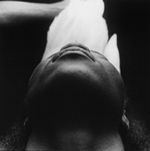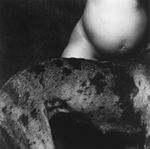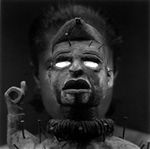The
Photographic Work of Mario Cravo Neto
By
Fernando Castro R.
 |
|
Africa
II 1991
|
A few years ago I read a Time magazine review of the book The History and Geography of Human Genes. The review revealed factual details of fifty years of population genetics research.1 Some of these facts seemed to me as momentous as the Copernican Revolution, the Theory of Evolution, and the discovery of DNA as the mechanism of heredity. Unfortunately, scientific facts are often incorporated into the functioning ideological background of society all too slowly. The one fact I would like to connect with my reflections of Mario Cravo Neto's work is that Europeans are genetic hybrids with 65% Asian genes and 35% African genes. In a sense, Cravo Neto's works express the truism that the manifestations in his culture of world mythologies belong to all people like him, and perhaps even, all of us. Thus, his work ought to be looked at not for its exoticism but for its catholicism.
A question that has puzzled me for many years is why so many Latin American artists are inclined to address issues of cultural identity, even when, at times, the particular cultural themes they treat are not connected with them genetically. Cravo Neto, for example, is not conspicuously African. Of course another fact of genetics is that what is conspicuous is only phenotypical whereas what defines an individual molecularly and therefore, what endures in heredity, is genotypical. Was it not the point of Nelson Pereira dos Santos' movie Tenda dos Milagres (1975) that many of the prominent European families of Bahia (Cravo Neto's hometown) were cousins of an Afro-Brazilian anthropologist they discriminated? Cravo Neto does not run away from the African culture of his world; quite the contrary, he immerses himself in it. With the 65/35 ratio as an established fact, no further argument is needed on the genealogical level to regard diverse communities simply as one human conglomerate. Its corollary is that there is no genetic foundation for any particular phenotypic group to claim dominance. On the other hand, the reason for concerning oneself with specific cultures of the world cannot be genetic affiliation (which is shared), but cultural milieu (which is heavily dependent on personal history).
 |
|
Sacrifice IV 1989
|
Cravo Neto is not, by any means, the first Brazilian artist to concern himself with Afro-Brazilian issues. He was preceded by the Brazilian filmmakers of the socalled Cinema Novo who in the 1960s and 1970s took up the banner of the African culture of resistance to the ideology of branqueamento (whitening) of Brazilian culture; among them, the two mentioned in this essay, Glauber Rocha and Nelson Pereira dos Santos. In music, poet Vinicius de Moraes and musician Baden Powell recorded the album "Os Afro-Sambas" (1966) which contained songs about Yoruba deities such as Iemanj‡, Xango and Ossanha. De Moraes described the effort thus, "... realizar un novo sincretismo: carioquizar, dentro do espirito do samba moderno, o candomblŽ afro brasile–o, dando-lhe ao mesmo tempo uma dimens‹o mais universal."2 (to undertake a new syncretism: to make the Afro-Brazilian candomblŽ in the style from Rio de Janeiro, within the spirit of modern samba, giving it at the same time a more universal dimension). Cravo Neto's contribution to this "new syncreticism" was to bring his sculptorical and staging sensitivities into the field of photography when the medium in Latin America was politically committed to its documentary mode.
For the middle class Latin American artist, the cultural manifestations which may not seem linked genetically to her/him are often the very ones that nurture her/him since childhood. This relationship is illustrated in images like "Shelter" (1990), where a fair-skinned child is held in dark-skinned arms. Conflicts with one's nurturing world arise as one's historical awareness matures and it becomes poignantly clear that one belongs simultaneously to the culture of the victors who write official historiography and also that of the victims, whose history official historiography hides. It is a very pressing conflict because inaction implicates you as accomplice. When resolution is sought in art its aim is to restore the vision, value, and history of those marginalized from mainstream culture and for the artist, to culturally find her/himself in the world.
 |
|
Torso
with dog 1989
|
The African, Amazonian and European beliefs, customs, habits, values, rituals, and myths penetrate so deeply in the psyche of the Brazilian artist that art becomes a cathartic potion that brings it all out. Through art the artist may become all manifestations and none, he becomes predator and prey, slave and master, observer and observed. Cravo Neto searches with the medium of photography like the Amazonian shaman who drinks an ayahuasca potion so he can journey to the self of the jaguar, the howler monkey, the sloth, the anaconda, the toucan and the pink dolphin. In his journey across selves the shaman looks at his own persona and at the world through the eyes of his hosts in order to seek his own self in the world. After all, isn't what we are some summation of how others look at us and how we look at them?
Cravo Neto's inclusion of his own son, mother and father in this journey of self-discovery sustain this interpretation of his work. His mother's forehead and his father's gaze framed by his own fingers, are not exactly peaceable depictions. There is tension and anguish in them. Putting aside personal realities, their tense involvement in Cravo Neto's larger opus leads one to believe that the transmission of culture from generation to generation takes place with friction. It is a conclusion which echoes Freudian behavioral archetypes which typically allude to Greek-Roman mythologies. Saturn devouring his own children is a powerful metaphor for extreme authoritarianism, for the past imposing itself on the present, for cultural dominance, etc. That Cravo Neto alternates OdŽ with Saturn, voodoo with satyrs, points to either a commonality of all mythical cosmologies or their syncretism in Brazilian culture.
 |
|
Africa
III 1991
|
Staged photography is Cravo Neto's central poetics. He not only stages rituals as might be the case with "Sacrifice V" (1989); but also actual mythologies like "Saturno" (1992). This histrionics of the photographic act, also refer us back to filmmakers like Glauber Rocha. In his film Antonio das Mortes (1969), Rocha's aesthetic of artificiality is not contrary to the veracity of the documentary. Instead, it is an alternative way to enunciate the facts of society, history and culture. It is a way, also, that dispels the deceptive verisimilitude of First World Cinema. For Cravo Neto, the studio is the place of revelation, construal and memory. It is also a place where the artist's inclinations converge and blend: sculpture comes alive, photographs gain texture and depth, actors direct and incarnate, props become elements of an installation, objects metamorphose into amulets, optical effects synaesthesize acoustic features. Cravo Neto's use of photography as a medium (a transfiguring potion) transports the mind, transforms reality, and translates symbols from text to image, from a datum in the subconscious to a representation of the expressive mind. His work probes into the wealth of myths that inhabit him and quite possibly, us.
Fernando
Castro R.
Houston, Texas
You may contact Fernando Castro R. at: eusebio9@earthlink.net
1. Luca Cavalli-Sforza, Paolo Menozzi, and Alberto Piazza.The History and Geography of Human Genes. Princeton University Press:1995. (back)
2. "To bring about a new syncretism: To turn carioca, within the spirit of modern samba, the Brazilian candomble, giving it a more universal dimension". (back)